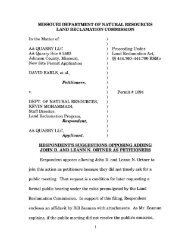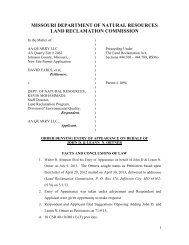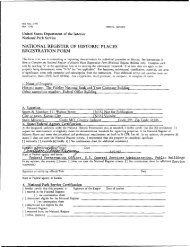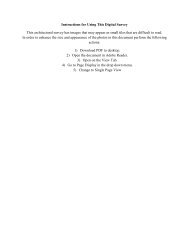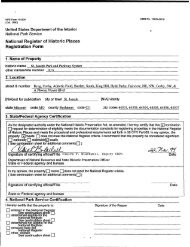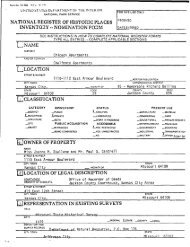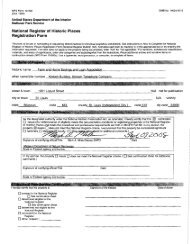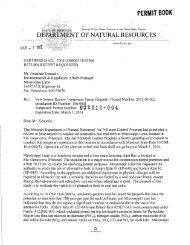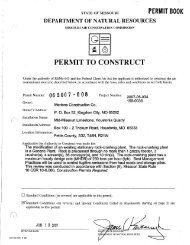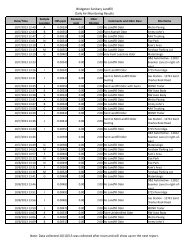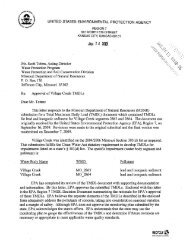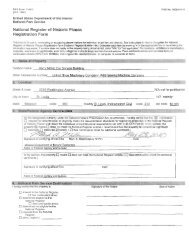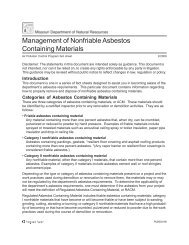clean fill - Missouri Department of Natural Resources
clean fill - Missouri Department of Natural Resources
clean fill - Missouri Department of Natural Resources
You also want an ePaper? Increase the reach of your titles
YUMPU automatically turns print PDFs into web optimized ePapers that Google loves.
<strong>Department</strong> <strong>of</strong> <strong>Natural</strong> <strong>Resources</strong><br />
Solid Waste Management Program<br />
Using Painted Block and Brick as Clean Fill<br />
Updated January 31, 2003<br />
We have all seen signs posted at construction sites advertising the need for “<strong>clean</strong> <strong>fill</strong>”, and<br />
probably have given the term little thought. Simply put, <strong>clean</strong> <strong>fill</strong> is material used to bring a site<br />
to a desired elevation or grade, <strong>of</strong>ten to provide a firm base for building or parking lot<br />
construction. What most people don’t realize is that there is a legal definition <strong>of</strong> <strong>clean</strong> <strong>fill</strong>. The<br />
<strong>Missouri</strong> Solid Waste Management Law defines <strong>clean</strong> <strong>fill</strong> as:<br />
Uncontaminated soil, rock, sand, gravel, concrete, asphaltic concrete, cinder blocks, brick<br />
minimal amounts <strong>of</strong> wood and metal, and inert solids as approved by rule or policy <strong>of</strong> the<br />
department for <strong>fill</strong>, reclamation or other beneficial uses.<br />
By far the most frequently asked question regarding <strong>clean</strong> <strong>fill</strong> is the meaning <strong>of</strong> the term<br />
‘uncontaminated.’ There is really no question as to whether virgin natural materials such as soil,<br />
sand, and gravel should be used as <strong>clean</strong> <strong>fill</strong>. Material that meets this definition may be used as<br />
<strong>fill</strong> in nearly any capacity you chose as long as you don’t place it in wetlands, floodplains, or<br />
classified waterways without permission from the proper authorities. However, there are some<br />
questions surrounding the use <strong>of</strong> demolition debris such as asphalt, concrete, concrete blocks,<br />
and bricks as <strong>clean</strong> <strong>fill</strong>, particularly when the material has been painted. Under no circumstances<br />
should demolition debris, painted or unpainted, be placed directly in contact with water bodies<br />
such as lakes, streams, or rivers. However, if the demolition material described above is <strong>clean</strong><br />
and unpainted, it is also for more or less unrestricted use.<br />
In January, 2001, the department’s technical bulletin titled Managing Construction and<br />
Demolition Waste was revised to allow the use <strong>of</strong> painted demolition debris to be used as <strong>clean</strong><br />
<strong>fill</strong> as long as the paint itself is not a heavy metal based paint. Though our policy concerning the<br />
use <strong>of</strong> painted material as <strong>clean</strong> <strong>fill</strong> has not yet been fully developed, certain aspects have been<br />
determined at this point. Please understand that we consider this policy to be a work in progress,<br />
and intend to develop a workable, practical approach to this issue that is protective <strong>of</strong> the<br />
environment. This guidance document outlines the department’s policy to date.<br />
What is a heavy metal?<br />
The department has determined that the heavy metals <strong>of</strong> concern are the eight (8) metals listed in<br />
the Code <strong>of</strong> Federal Regulations, 40 CFR Part 261, Table 1 – Maximum Concentration <strong>of</strong><br />
Contaminants for the Toxicity Characteristic. These metals are commonly referred to as the<br />
Resource Conservation and Recovery Act (RCRA) metals. They are:<br />
arsenic, barium, cadmium, chromium, lead, mercury, selenium, and silver.
Page 2<br />
What testing is required?<br />
Testing can be done either by wet chemistry (total concentration analysis) or by using an x-ray<br />
fluorescence (XRF) instrument. Most laboratories in the state are able to routinely perform wet<br />
chemistry testing. Acceptable test methods we have seen to date include Environmental<br />
Protection Agency (EPA) SW 846, Methods 6010B and 3050B. The sample must be <strong>of</strong> the paint<br />
only, and cannot include the substrate. The results are normally reported in milligrams per<br />
kilogram (mg/kg) which is equivalent to parts per million (ppm). Laboratory reports must be<br />
included if the information is submitted to the department. Make sure the laboratory report<br />
indicates the detection limit <strong>of</strong> the test method.<br />
XRF testing is more specialized and usually requires that you hire an experienced consultant.<br />
We are still learning about this process. However, based on the limited data we have seen to<br />
date, we have determined that for XRF testing a detailed report must be submitted containing the<br />
following information:<br />
A printout or summary <strong>of</strong> the test results<br />
Color <strong>of</strong> paint<br />
Type <strong>of</strong> paint if known (latex, oil based enamel, etc.)<br />
Number <strong>of</strong> coats <strong>of</strong> paint<br />
Type <strong>of</strong> substrate (bricks, concrete, concrete block, etc.)<br />
Type <strong>of</strong> application (interior vs. exterior)<br />
Relative roughness <strong>of</strong> the surface<br />
Test detection limits and how they were derived<br />
Exposure times<br />
Other factors affecting the interpretation <strong>of</strong> the results, as specified by the instrument<br />
manufacturer<br />
What testing frequency should I use?<br />
Regardless <strong>of</strong> the testing method or the size <strong>of</strong> the building, the department requires a minimum<br />
<strong>of</strong> one (1) test for each type and color <strong>of</strong> paint present in each building. Should a particular color<br />
or type <strong>of</strong> paint be present in quantities greater than approximately 5,000 square feet <strong>of</strong> surface<br />
area, one sample <strong>of</strong> the paint for every 5,000 square feet <strong>of</strong> painted surface, or fraction there<strong>of</strong>,<br />
must be collected. In other words, if there are 6,500 square feet <strong>of</strong> surface area painted with a<br />
particular color <strong>of</strong> paint, two (2) tests are required. For 14,000 square feet, three (3) tests are<br />
required, and so on.<br />
When is a paint a heavy metal based paint?<br />
Lead based paint is defined as paint that contains:<br />
• One milligram <strong>of</strong> lead per square centimeter <strong>of</strong> surface area, or<br />
• One half <strong>of</strong> one percent (0.5%) lead (equal to five thousand (5,000) ppm)
Page 3<br />
This definition is well established, and is used by Housing and Urban Development (HUD) and<br />
the Environmental Protection Agency (EPA). No material painted with lead based paint may be<br />
used as <strong>clean</strong> <strong>fill</strong>, regardless <strong>of</strong> its origin<br />
We are not aware that there are any other defined heavy metal based paints. This determination<br />
will be made by the department on a case by case basis.<br />
Are there different requirements for residential structures vs. non-residential structures?<br />
Yes. For the purposes <strong>of</strong> this guidance document, residential structures are defined as single<br />
family dwellings and multi-family dwellings <strong>of</strong> up to four family units. For residential<br />
structures, lead is the only metal <strong>of</strong> concern. Testing for other RCRA metals is not necessary. In<br />
other words, for residential structures, you must only determine whether the material is painted<br />
with lead based paint. If it is not, then material that would otherwise be <strong>clean</strong> <strong>fill</strong> may still be<br />
used as such. While you should keep the test results in your records, you do not have to submit<br />
them to the department for approval.<br />
For non-residential structures, you must test for all eight RCRA metals. As for residential<br />
structures, material painted with lead based paint is not acceptable for use as <strong>clean</strong> <strong>fill</strong>.<br />
However, we have not yet determined the levels <strong>of</strong> other RCRA metals that classify them as<br />
heavy metal based paints. In other words, the acceptable maximum levels for the other RCRA<br />
metals in paint on <strong>clean</strong> <strong>fill</strong> material from non-residential structures has not yet been determined.<br />
However, Table 1, below, gives the maximum levels <strong>of</strong> RCRA metals in paint on <strong>clean</strong> <strong>fill</strong> that<br />
have been approved to date. We consider the painted material to be <strong>clean</strong> <strong>fill</strong> if testing reveals<br />
that the concentrations <strong>of</strong> RCRA metals in the paint are equal to or below these levels:<br />
Table 1<br />
As Ba Cd Cr Pb Hg Se Ag<br />
Maximum approved 87 15,200 429 3,285 4,999* 100 50 99<br />
Levels, ppm<br />
* ‘Lead-based paint’ is defined as paint containing at least 5,000 ppm lead, or 0.5% lead.<br />
Material painted with lead based paint may not be used as <strong>clean</strong> <strong>fill</strong>. Material coated with<br />
paint containing up to 4,999 ppm lead may still be used as <strong>clean</strong> <strong>fill</strong>.<br />
If testing reveals that the levels <strong>of</strong> metal in the paint are below the levels in the table, you may<br />
use the material as <strong>clean</strong> <strong>fill</strong> without submitting the test results to the department. Keep the test<br />
results for your records. If the levels <strong>of</strong> metal in the paint are above the levels in the table and<br />
you still wish to pursue its use as <strong>clean</strong> <strong>fill</strong>, you may elect to perform further testing using the
Page 4<br />
synthetic precipitation leaching procedure (SPLP) test, EPA SW 846, Method 1312, on the paint<br />
(with no substrate included). This additional testing is only necessary for those metals found to<br />
be above the appropriate levels in Table 1, above. Compare the test results to the water quality<br />
standards in the <strong>Missouri</strong> State Code <strong>of</strong> Regulations, 10 CSR 20-7, Table A – Criteria for<br />
Designated Uses. This table may be viewed by visiting the <strong>Missouri</strong> Secretary <strong>of</strong> State’s website<br />
at following address:<br />
http://www.sos.state.mo.us/adrules/csr/current/10csr/10c20-7b.pdf<br />
If SPLP testing reveals that the concentration <strong>of</strong> the particular metal in the extract <strong>of</strong> the material<br />
is below the water quality standards for that metal, the material is <strong>clean</strong> <strong>fill</strong>. In other words, if<br />
the metal doesn’t leach out above the lowest water quality standard in Table A using the SPLP, it<br />
is <strong>clean</strong> <strong>fill</strong>. Again, the test results should be kept in your records, but they do not have to be<br />
submitted.<br />
If XRF or wet chemistry testing reveals that the concentration <strong>of</strong> any RCRA metal in the paint,<br />
other than lead, is at or above the level for the metal in the table, and you do not wish to perform<br />
the additional SPLP tests, the XRF or wet chemistry results must be submitted to the<br />
department’s SWMP for review. The allowable maximum levels for RCRA metals, other than<br />
lead, in paint on <strong>clean</strong> <strong>fill</strong> material, will be determined on a case-by-case basis for the immediate<br />
future. Table 1 will be revised accordingly as these determinations are made. To reiterate, the<br />
maximum level for lead is always the HUD definition <strong>of</strong> lead based paint, regardless <strong>of</strong> whether<br />
the structure is residential or not.<br />
These procedures are subject to change as data becomes available regarding the metal content<br />
and the leachability <strong>of</strong> metals in paint. Any data you might have in your possession concerning<br />
the metal content <strong>of</strong> paint will assist us in our efforts; we will welcome copies <strong>of</strong> any test results<br />
you may have.<br />
If you have any further questions, please feel free to contact the Special Projects Unit staff at<br />
(573) 751-5401.



